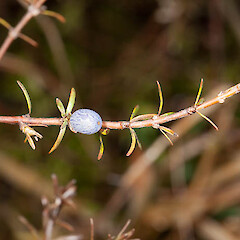Coprosma brunnea
Common name
coprosma
Synonyms
Coprosma acerosa f. brunnea Kirk
Family
Rubiaceae
Flora category
Vascular – Native
Endemic taxon
Yes
Endemic genus
No
Endemic family
No
Structural class
Trees & Shrubs - Dicotyledons
NVS code
The National Vegetation Survey (NVS) Databank is a physical archive and electronic databank containing records of over 94,000 vegetation survey plots - including data from over 19,000 permanent plots. NVS maintains a standard set of species code abbreviations that correspond to standard scientific plant names from the Ngä Tipu o Aotearoa - New Zealand Plants database.
COPBRU
Chromosome number
2n = 44
Current conservation status
The conservation status of all known New Zealand vascular plant taxa at the rank of species and below were reassessed in 2017 using the New Zealand Threat Classification System (NZTCS) – more information about this can be found on the NZTCS website. This report includes a statistical summary and brief notes on changes since 2012 and replaces all previous NZTCS lists for vascular plants.
Please note, threat classifications are often suggested by authors when publications fall between NZTCS assessment periods – an interim threat classification status has not been assessed by the NZTCS panel.
- Conservation status of New Zealand indigenous vascular plants, 2017 . 2018. Peter J. de Lange, Jeremy R. Rolfe, John W. Barkla, Shannel P. Courtney, Paul D. Champion, Leon R. Perrie, Sarah M. Beadel, Kerry A. Ford, Ilse Breitwieser, Ines Schönberger, Rowan Hindmarsh-Walls, Peter B. Heenan and Kate Ladley. Department of Conservation. Source: NZTCS and licensed by DOC for reuse under the Creative Commons Attribution 4.0 International licence.
2017 | At Risk – Declining | Qualifiers: DP, Sp
Previous conservation statuses
2012 | Data Deficient
2009 | Not Threatened
2004 | Not Threatened
Brief description
Sprawling yellowish small-leaved shrub inhabiting inland open rocky areas. Twigs pale orange, slightly fuzzy at tip. Leaves narrow, small, with dark line down middle on the underside, in clusters of pairs scattered along twigs. Flowers tiny, with long protruding threads. Fruit streaked purple.
Distribution
Endemic. South Island and Stewart Island/Rakiura. Nelson and the drier regions of central and eastern South Island.
Habitat
Lowland to alpine. To 1500 m. Often common on stony riverbeds and terraces but also in subalpine scrub and occasionally on open rocky sites in tussock-herbfield.
Detailed description
Prostrate to sprawling with slender flexible interlacing branches and branchlets forming flattened usually rather open wiry mats up to approximately 2 m across, occasionally reaching 1 m or more in height when in scrub. Branches with dark brown bark, branchlets pubescent. Stipules broadly triangular, obtuse, pubescent, ciliolate. Leaves sparse, in opposite pairs or fascicles on very short petioles; lamina coriaceous, dark brownish green, glabrous, linear, obtuse, 5–8–(13) × 0.5–1 mm; midrib alone evident. Flowers solitary, terminal on short leafy branchlets; male flower with calyx vestigial or non-existent, corolla broadly campanulate, lobes acute, more or less equal to tube; female flower with calyx minutely toothed, corolla tubular, lobes acute, more or less equal to tube. Drupe translucent pale blue or with pale blue flecks, globose, 5–6 mm diameter.
Manaaki Whenua Online Interactive Key
Similar taxa
Coprosma acerosa grows in different habitats (C. acerosa prefers coastal sands throughout its distribution) and the two species are not thought to overlap naturally. C. acerosa is generally a more compact growth form with more leaves present.
Coprosma intertexta is bushy but not stiffly erect; the leaves are sharp-tipped in outline and usually red-margined.
Flowering
September–December
Flower colours
Yellow
Fruiting
February–June
Propagation technique
Easy from fresh seed, semi-hardwood cuttings and rooted pieces. Prefers free draining soil in a sunny position. Most nursery stock sold over the last few decades as this species is not C. brunnea but an allied segregate of C. acerosa endemic to the Central Volcanic Plateau of the North Island.
Threats
Coprosma brunnea is now uncommon over large parts of its range—it is often heavily browsed by rabbits and hares and its habitat is modified by gorse (Ulex europaeus) and broom (Cytisus scoparius).
Etymology
coprosma: From the Greek kopros ‘dung’ and osme ‘smell’, referring to the foul smell of the species, literally ‘dung smell’
brunnea: From the Latin brunneus ‘deep brown’
Where To Buy
Occasionally offered by retail plant and specialist native plant nurseries.
Notes on taxonomy
Coprosma brunnea is part of the C. acerosa A.Cunn. complex, and many botanists prefer to regard it as either C. acerosa or a form of it. However, C. brunnea has been found growing sympatrically with C. acerosa, and remaining distinct from it, while nrDNA ITS and ETS sequences show that C. acerosa is a complex aggregate of at least 6 lineages (C. brunnea is one of these), and there are subtle morphological characters to support these lineages. Therefore, until further research is conducted into this problem NZPCN think it better to retain C. brunnea at the rank of species.
Attribution
Description adapted by M. Ward from Allan (1961), Mark (2012), and Wilson & Galloway (1993).
References and further reading
Allan HH. 1961. Flora of New Zealand, Volume I. Indigenous Tracheophyta: Psilopsida, Lycopsida, Filicopsida, Gymnospermae, Dicotyledones. Government Printer, Wellington, NZ. 1085 p.
Mark A F. 2021. Above the Treeline: A Nature Guide to Alpine New Zealand, 2nd edition. Potton Burton, Nelson, NZ. 433 p.
Wilson HD, Galloway T. 1993. Small-leaved shrubs of New Zealand. Manuka Press, Christchurch, NZ. 305 p.





